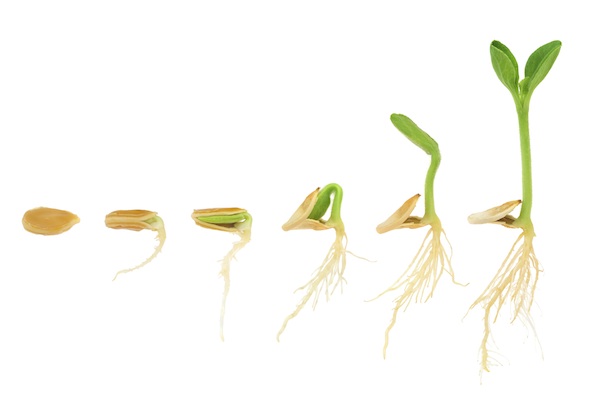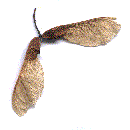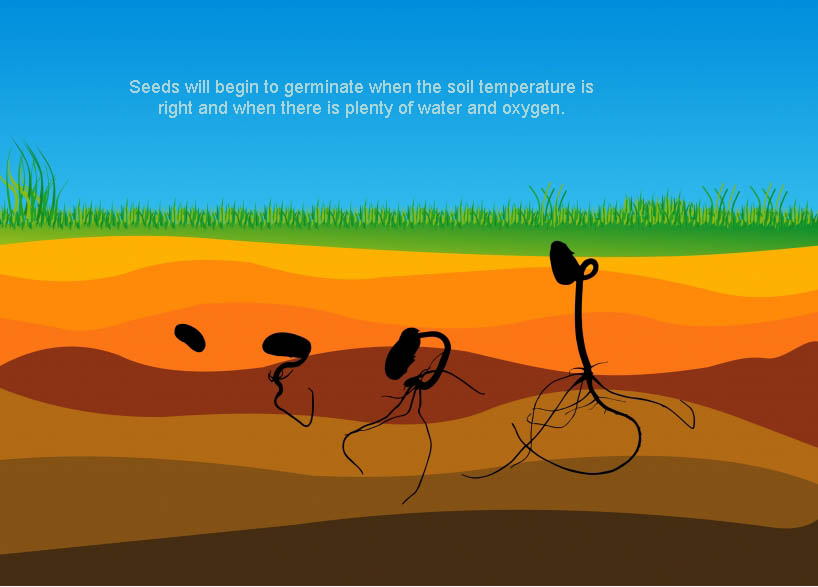Plants make seeds.
They spread the seeds so they can grow.
The seeds grow into the same kind of plant.
Bulbs are similar to a seed.
They look like onions.
They grow into plants too.
Some plants begin as seeds.
Pollen from this flower sticks to the bee and will mix with pollen at the next flower it visits. ©Getty
Seeds start inside the flowers of a plant. They start to grow when the flower is touched by pollen from another flower of the same kind. Pollen is a yellow powder inside the flower.
Bees and other insects as well as some birds and bats carry the pollen from flower to flower. This is called pollination. Pollens can also be carried by the wind. This can make people sneeze and their eyes itch.
When the flower dies, the seeds keep growing inside pods or the fruit of the plant, and when they are ready, they must leave the plant in order to grow. The seeds are scattered by the plant and when the seeds fall to the ground, new plants grow. This is called dispersal.
Not all seeds become new plants: many kinds of seeds are food for people. Seeds such as rice, corn, peas, beans, nuts, lentils and many others can be eaten. Farmers keep some of the seeds for planting and the rest are sold for food.
Seed dispersal
Of course, not all seeds are dispersed to grow somewhere by themselves, special nurseries grow plants and collect the seeds so that people can plant them. The seeds are bought in a packet ready for gardeners.
People can buy seeds for planting in their gardens. These seeds are not dispersed by the plant but harvested in nurseries and packed for sale. ©Getty
However, natural dispersal takes several forms, each suited to the plant's needs and habitat.
For many plants, the seeds are spread some distance away so that the new plants don't compete with the parent plants for space, food and sunlight. Plants use different methods of dispersing their seeds.
Gravity
Some plants use gravity to spread their seeds by simply letting the seeds fall to the ground. Many plants that are annuals, that is, live for just one season, do this. It works for them because the parent plants die off so they don't compete with the new plants when they grow.
Double seeds form wings that spin through the air. ©Getty
Air
The wind scatters the seeds of some plants. There are many different examples of this: some seeds are cased in wing-like pods that spin off and are carried quite a distance, some seeds float gently away.
Because many of the seeds carried by air will land in places where they can't grow, plants that use this method produce lots of seeds to ensure that some will land where they can grow.
When the poppy seeds are ready, little holes form at the top of the seed case. The breeze makes the stem move, and the seeds fly out of the holes. ©Getty
Some plants use air differently. A few plants 'explode' their seeds into the air so they fly away in the breeze. Plants with seed pods do this: the pod pops open and the seeds fly out.
Poppy seeds form inside a case on the thin flower stem when the flower dies. When the seeds are ready, tiny holes form on top of the case, like a pepper pot. The breeze shakes the stem and makes the case shake so the tiny seeds sprinkle out.
Monkeys like this squirrel monkey are good seed dispersers because they wander widely through their habitat eating fruit as they go. The seeds pass out of their bodies far away from the tree where it was gathered. ©Getty
Animals
Some seeds spread by grabbing a ride from birds, insects and animals (including humans). Some of those seeds have a sticky or prickly covering that just attaches to a passerby and drops off somewhere else.
Some seeds are inside a delicious fruit that animals eat as they wander, and the seeds pass out of the animal in its poo, usually far away from the parent plant.
Many trees, for example nut trees, just drop their seeds onto the ground using gravity, but the seeds are collected by animals who eat them or hide them away to eat later. Those secret stashes of nuts are sometimes forgotten, and are able to grow.
These coconut seeds have washed ashore and some are beginning to sprout ©Getty
Water
Water also is a method of dispersal. Many plants that live near water have seeds that float away, many of which will be washed on to land where they can grow. The coconut is one example of this, the seed even carries a supply of fresh water inside it that will keep it alive until it can spread roots and grow.
The open 'mouths' of these banksia cones have exploded their seeds into the air after a bushfire has died down. ©Getty
Some plants need special conditions in which to release their seeds. This is to ensure the seeds' survival. Some kinds of Australian plants require heat before the seed cases open.
Some of the banksia species are an example of this: after a fire has passed, each of the small seed cases on the seed cone pop open and propel the seeds some distance away. The soil has been enriched by the ash after a fire and the seeds are more certain to grow.
When people want to collect seeds of this kind of plant, they put the seed cones into a paper bag and into a warm spot, such as an oven that has been turned off. The pods open and seeds are released into the bag.
Germination
Inside the ground, when the soil is the right temperature and there is enough water and oxygen, the seeds begin to grow.
This is called germination.
First the roots begin and grow bigger, and then a green shoot pushes up out of the ground towards the light.
When the shoots grow above the ground, they are called seedlings.
© Getty
Some plants begin as bulbs.
Bulbs look a bit like onions. Most grow in spring.
Sprouting bulbs . ©getty
Bulbs are dormant (sleep) for most of the year, but when the soil temperature is right for them theybegin to grow under the ground.
Roots grow first, reaching down into the soil and then a green shoot starts to poke through the top of the bulb.
It gets bigger and bigger and leaves start to show.
A flower stem grows. The bud at the end of the stem is closed tight. As the weather gets warmer, the bud opens and the flower can be seen.
Daffodils, tulips and other spring bulbs in bloom ©Getty
Daffodils and tulips are two kinds of bulb that flower in spring.
It is always a good idea to use more than one source of information, so here are some others for you to investigate
Read more about seeds and bulbs:
How seeds grow ( video)
Watch a video about planting bulbs
Dandelion seeds float like tiny parachutes. ©Getty













